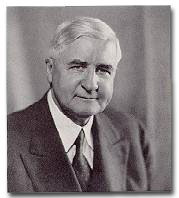GREAT CITIZENS - JESSE HOLMAN JONES
 Financier, banker, lumberman, civic leader and federal administrator, six-foot-six-inch Jesse Holman Jones was a contemporary of Clayton's who also made an impact both locally and nationally. Jones was born on April 5, 1874 in Robertson County, Tennessee to Laura Anna (Holman) and William Hasque Jones, a successful farmer and tobacco exporter. In 1883, his father moved the family to Dallas, Texas where, in the early 1890's Jones began to work in the lumber firm of his uncle.
Financier, banker, lumberman, civic leader and federal administrator, six-foot-six-inch Jesse Holman Jones was a contemporary of Clayton's who also made an impact both locally and nationally. Jones was born on April 5, 1874 in Robertson County, Tennessee to Laura Anna (Holman) and William Hasque Jones, a successful farmer and tobacco exporter. In 1883, his father moved the family to Dallas, Texas where, in the early 1890's Jones began to work in the lumber firm of his uncle.
Between 1895 and 1905, Jones rose to the position of manager of the Dallas office and then to general manager of the entire company, moving to Houston in 1898 after the death of his uncle. He later established the South Texas Lumber Company and, in 1904, the Jesse H. Jones Lumber. The same year, he was awarded the contract to furnish the lumber for the Texas Building at the St. Louis Louisiana Purchase Exposition.
Houston became the center of Jones' various enterprises. He also expanded into banking, real estate and the development and construction of commercial buildings. From 1910 to 1930, the initial "skyscraper" era in Houston, he was the major developer in the city, involved in the erection of most of Houston's major office buildings along Main Street. Among the twenty or so buildings he constructed were the Kirby, Commerce, Milam, Rusk, Mason, Electric and C & I Insurance buildings.
In December 1920, Jones married Mary Gibbs of Mexia, Texas. He bought and published the Houston Chronicle and became president of the National Bank of Commerce, the forerunner of Texas Commerce Bank, and of the Bankers Mortgage Company.
Through a large party contribution, and by financing a new convention hall, Jones assured the selection of the city as the site of the 1928 Democratic National Convention. After Franklin Roosevelt nominated Alfred E. Smith as a candidate for president, it was common to hear the question, "How can you be any more Democratic than Smith and Jones?"
During the Great Depression, Jones called Houston's leading bankers together and persuaded them to accept a plan to prevent smaller city banks from failing. Since the beneficial effect of his leadership extended beyond the limits for the city and the state, Jones' actions brought him national recognition. In 1932, President Herbert C. Hoover appointed him to the Board of the Reconstruction Finance Corporation and the following year, President Franklin D. Roosevelt also appointed him to the board of the Export-Import Bank (1936 to 1943), and to the posts of administrator of the Federal Loan Agency (1939 to 1945) and Secretary of Commerce (1940 to 1945). He supervised the New Deal lending programs and, although his New Deal Colleagues considered that many of his policies were too conservative for their taste, he protected hundreds of individual banks, railroads and industrial plants from financial failure. Considered a controversial figure within the administration, Jones nevertheless exerted considerable influence as an intermediary between the administration and the business community.
He did not neglect local affairs, even while involved in the higher echelons of federal government. He was director-general of the Texas Centennial celebration held in 1936. In April 1937, at ceremonies held at the San Jacinto Battleground, he sealed the cornerstone of the San Jacinto Monument, the tallest masonry monument in the United States. In recognition of his service to the state of Texas and to the nation, the state legislature commissioned an official portrait of Jones, unveiled in 1935 in the state capitol in Austin. He served as chairman of the Texas committee for the 1939 New York World's Fair and for the San Francisco Golden Gate Exposition.
In 1940, Jones was greatly disappointed when he failed to gain the nomination as the Democratic Party's vice-presidential candidate. From then on he became increasingly supportive of anti-Roosevelt political factions. In January 1945, President Roosevelt asked Jones to resign as Secretary of Commerce and from the Federal Loan Agency as well. Although Roosevelt offered him other posts, Jones refused them and later withheld the Houston Chronicle's editorial support from Democratic Party nominees in the election years 1948 and 1952.
Before he died in Houston on June 1, 1956, at the age of 82, he and his wife established a charitable foundation called Houston Endowment, Inc. His name is immortalized in the Houston Civic Center's Jesse H. Jones Hall for the Performing Arts, which opened in 1968, and the Jesse H. Jones Library at the Texas Medical Center in Houston.






